|
|

This tutorial provides an example on creating a new scenario in order to simulate a LAN segment failing along the path from one end system to another end system. The tutorial in "Round Trip IP Connectivity Requirements" is the basis for this tutorial. However, as this tutorial modifies router attributes to simulate a LAN failure, the tutorial_baseline scenario must be modified. Therefore, the tutorial_baseline scenario can not be used. A new scenario must be created.
The following tasks were performed and described in the previous tutorial:
The following tasks are performed and described in this tutorial:
Having proceeded through the steps of creating and opening the tutorial_baseline baseline, as described in the first tutorial, the Connectivity Tools window, shown in Figure 8-1, is displayed. See "Creating and Opening a Baseline" for information on how to create and open a baseline.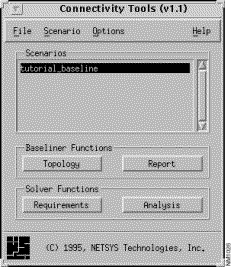
Step 1 Select the Scenario>Create New option.
The tutorial_baseline+ scenario is created, selected, and displayed in the Connectivity Tools window, as shown in Figure 8-2. This newly created scenario can be used for simulation and analysis purposes.
Step 2 Click on the Topology button in the Connectivity Tools window.
A campus view of the tutorial_baseline+ scenario's topology is displayed in the Topology window.
Step 3 Select the View>Flat and Show>Router Labels menu options in the Topology window.
The tutorial_baseline+ topology, shown in Figure 8-3, is displayed in a flat, IP view with router labels displayed.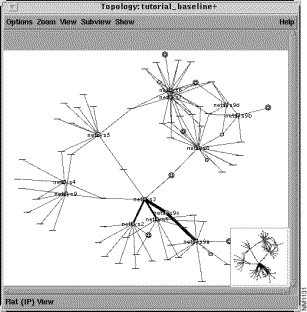
Step 4 Click on the Requirements button in the Connectivity Tools window.
Clicking on the Requirements button allows you to create and load a set of connectivity requirements. The Requirement Sets window is displayed, as shown in Figure 8-4.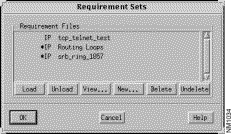
A list of existing requirement file sets is displayed in the Requirement Files list. A requirement file set contains network connectivity requirements for the baseline.
Requirement File entries preceded by an asterisk indicate connectivity requirements implicitly derived from the router configuration files. These connectivity requirement file sets can not be edited or deleted.
The implicitly derived Routing Loops requirement set is provided to find routing loops caused by IP redistribution. When you select the Routing Loops requirement set and then load it for analysis by clicking on the Load button followed by the OK button, a list of all the redistribution IP routing loops detected during analysis is displayed in the Requirements Analysis window. The results are a set of paths showing the identified routing loops. Each path displays a source address set to a port address of a router involved in the loop and a destination, which is a subnet or end point address, identifying the Routing Table destination involved in the routing loop. The path also shows a set of routers involved in a loop.
Load the previously created connectivity requirements found in the tcp_telnet_test requirement file set for analysis.
Step 5 Select the tcp_telnet_test file set from the Requirement Files list, then click on the Load button followed by the OK button.
The connectivity requirement file set loaded for analysis is prefixed by the identifier LOAD in the Requirement Files list. The results of the connectivity requirements are viewed from the Requirements Analysis window, partially shown in Figure 8-5. That is, the status of each connectivity requirement loaded for analysis, is viewable. One path was found providing the required connection between the source end system (netsys9b) and the destination end system (netsys9a).
Step 6 Select the entry from this window to highlight the route between the two end systems in the Topology window, as shown in Figure 8-6.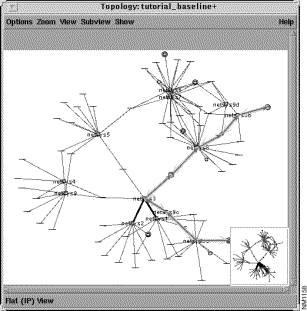
The thicker highlighted line represents the route from the source router (netsys9b) to the destination router (netsys9a). The thinner highlighted line represents the return path from the destination router (netsys9a) to the source router (netsys9b).
Step 7 Double-click on the selected connectivity requirement entry in the Requirements Analysis window.
A corresponding Round Trip Path window is displayed, as shown in Figure 8-7. This window provides the end system names, addresses, and ports, the current status of the path, and a list of the devices and network elements that make up the path from the source end system to the destination end system, and back. Based on this information and the information provided in the Topology window, the current connectivity requirements selected can be identified not only from a component standpoint, but visually as well.
Step 8 Select the netsys3.fddi3/0.0 (132.108.50.0) entry in the Round Trip Path list.
This LAN component is now highlighted in the Topology window.
Step 9 Double-click on the selected entry or on the highlighted netsys3.fddi icon in the Topology window to display the LAN Segment window as shown in Figure 8-8.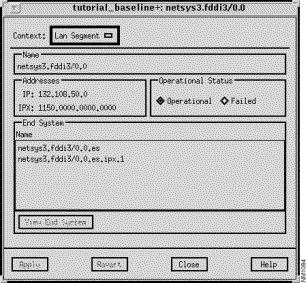
Step 10 Click on the Operational Status Failed button, then click on the Apply button.
The netsys3.fddi3/0.0 LAN segment is set to a failed state. Notice the netsys3.fddi3/0.0 icon in the Topology window is red (indicating failure).
Step 11 Click on the Analysis button in the Connectivity Tools window.
Analysis of the tutorial_baseline+ connectivity requirements is performed. Assess the status of the results. The tutorial_baseline+ Requirements Analysis window is updated, as shown in Figure 8-9.
Step 12 Select the connectivity requirements entry in the Requirements Analysis window.
A new path between the two end systems is highlighted, as shown in Figure 8-10. The new path reflects the route between the two end systems now that the netsys3.fddi3/0.0 LAN segment is in a failed state (its icon is red).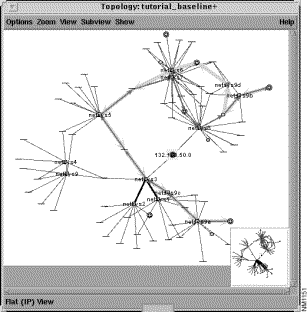
Step 13 Double-click on the selected connectivity requirements entry.
The tutorial_baseline+ Round Trip Path window is displayed, as shown in Figure 8-11. You can click on an entry in the Routes list to display the corresponding path in the Topology window.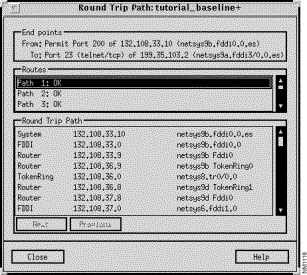
Next, fail router netsys8's incoming Token Ring interface (132.108.36.13), which is along the new path.
Step 14 Select the router 132.108.36.13 netsys8 entry in the Round Trip Path list.
This router is highlighted in the Topology window.
Step 15 Double-click on this entry in the Round Trip Path list.
The netsys8 Router Configuration window is displayed, as shown in Figure 8-12. 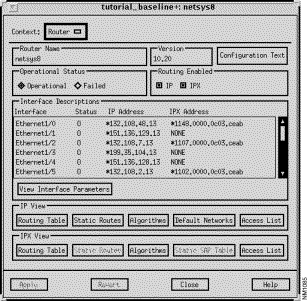
Step 16 Select interface TokenRing0/0 (132.108.36.13) from the Interface Descriptions list, then click on the View Interface Parameters button.
The Interface Parameters window is displayed, as shown in Figure 8-13.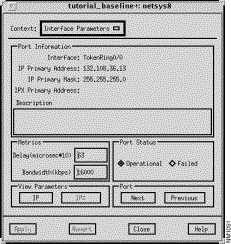
Step 17 Click on the Port Status Failed button, then click on the Apply button.
The TokenRing0/0 (132.108.36.13) router interface status is set to failed (not operational.)
Step 18 Click on the Analysis button in the Connectivity Tools window.
Analysis of the new configuration is performed. The results are displayed in the Requirements Analysis window.
Step 19 Click on the connectivity requirements entry in the Requirements Analysis window.
The route taken from the source end system (netsys9b) to destination end system (netsys9a) and back, is highlighted in the Topology window, as shown in Figure 8-14. Notice the return path from the destination end system to the source end system has changed.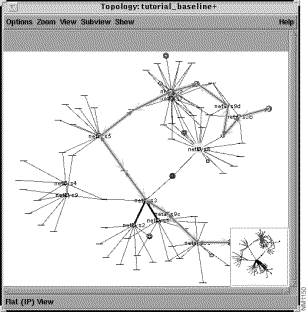
Step 20 Double-click on the entry in the Requirements Analysis window.
Step 21 Select the router 132.108.36.9 netsys9b entry in the Round Trip Path list in the Round Trip Path window.
This router (netsys9b) is now highlighted in the Topology window.
Step 22 Double-click on this entry to display the netsys9b Router Configuration window.
Step 23 Click on the Operational Status Failed button, then click on the Apply button.
The netsys9b router operational status is set to failed. Notice the netsys9b router icon in the tutorial_baseline+ Topology window is red (indicating failure).
Step 24 Click on the Analysis button in the Connectivity Tools window.
Analysis based on the modification is performed. Assess the status of the results. Notice the path from the source end system to the destination end system is now blocked, as partially shown in Figure 8-15.
Step 25 Click on the Operational button in the netsys9b Router Configuration window, then click on the Apply button.
The status of the router is now back to operational. Notice the netsys9b router icon in the tutorial_baseline+ Topology window is no longer red.
Step 26 Click on the Analysis button in the Connectivity Tools window.
Analysis of the new configuration is performed. The path's status is no longer blocked.
Step 27 Click on the Requirements button in the Connectivity Tools window.
Create another end system IP connectivity requirement set.
Step 28 Click on the New button in the Requirement Sets window.
Step 29 Name the new requirement file set deny_test, then click on the OK button in the New Requirement Set window.
The Requirements window is displayed.
Step 30 Click on the Add button in the Requirements window.
The Add IP Requirements window is displayed. Deny a FTP/TCP connection from port 220 of source end system netsys8.ether1/2.0.es (132.108.7.14) to port 21 of destination end system netsys1.ether1/4.0.es (199.35.38.7).
Step 31 Click on the OK button in the Add IP requirements window.
The Requirements window is displayed with the entry added to the deny_test requirement file set, as partially shown in Figure 8-16.
Step 32 Click on the OK button in the Requirements window.
The Requirements Set window is displayed. The deny_test requirement file set is displayed in the Requirements File list in the Requirement Sets window.
Step 33 Select the previously loaded requirements file (tcp_telnet_test) then click on the Unload button.
The tcp_telnet_test connectivity requirements are unloaded from analysis. Next load the deny_test connectivity requirements.
Step 34 Select the deny_test connectivity requirements file set from the Requirements File list, then click on the Load button followed by the OK button.
The deny_test set of connectivity requirements are loaded for analysis.
Step 35 Reanalyze the new connectivity requirements and inspect the results.
The results of the analysis on the deny_test connectivity requirements are displayed in the Requirements Analysis window, partially shown in Figure 8-17. A connectivity requirement entry with a SECURITY status indicates the connection is not permitted by an access list entry.
|
|